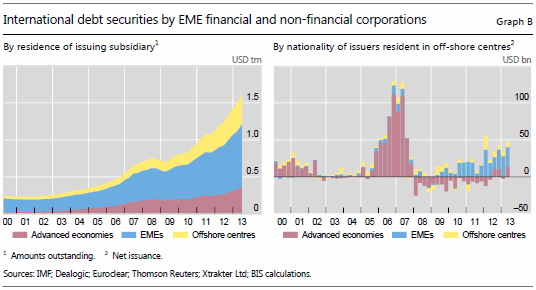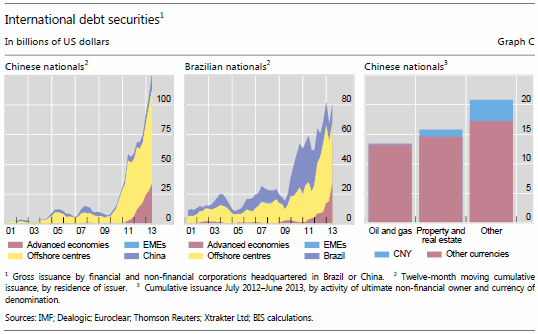Emerging market debt securities issuance in offshore centres
(Extract from pages 22-23 of BIS Quarterly Review, September 2013)
Financial and non-financial corporations from emerging market economies (EMEs) have increasingly turned to offshore financial centres (OFCs) to issue debt securities. At the end of June 2013, 25% of all international debt securities outstanding of EME corporates had been issued in OFCs, compared with 22% in the advanced economies (Graph B, left-hand panel). In the 12 months up to mid-2013, EME corporates raised $95 billion in OFCs, around one quarter of their overall issuance during that period. As a consequence, they have overtaken corporations headquartered in advanced economies ($32 billion) as the largest group of issuers in OFCs (Graph B, right-hand panel).
The surge in OFC issuance by EME corporations is primarily due to borrowers headquartered in just two countries, China and Brazil. Chinese firms' borrowing in OFCs shot up from less than $1 billion per annum in 2001 and 2002 to $51 billion in the 12 months up to mid-2013 (Graph C, left-hand panel). This amounts to approximately 70% of all international debt securities issued by Chinese financial and non-financial corporations. Brazilian firms have a much longer history of borrowing abroad, including in OFCs. After raising between $2 billion and $6 billion per year in OFCs between 2001 and 2005, they borrowed almost $20 billion between July 2012 and June 2013 (Graph C, centre panel). This represents 41% of total international issuance by Brazilian firms.
Issuing international bonds through controlled entities in OFCs allows Chinese and Brazilian firms to reach an investor base that would find it hard to invest locally.1 Many institutional investors do not have the mandates or the technical capacity to invest in EME domestic bond markets. And even if they do, purchasing bonds issued in OFCs lessens their administrative burden as a more homogeneous regime across investments helps to reduce the hazards of dealing with dozens of tax and legal frameworks. Bonds and other debt securities issued in OFCs are also attractive to some investors for tax-reasons. Many countries apply withholding tax to investors resident in foreign jurisdictions that have an income tax rate lower than 20%. This group includes OFCs, where many funds that invest in emerging markets are registered. Finally, bonds issued by affiliated entities in OFCs may be less likely to be affected by capital controls than domestic securities. That said, this possibility should not be exaggerated: the government can also rule that foreign assets should be repatriated.
On the surface, the picture looks different for China. In contrast to Brazil, Chinese corporations have traditionally financed themselves domestically. At the same time, sustained growth and integration of the Chinese economy increases the demand of international investors for Chinese financial assets. It is therefore often cheaper for Chinese nationals to raise funds abroad than domestically. This is particularly obvious for securities denominated in renminbi, where offshore yields tend to be well below those in China.2 As a consequence, a significant share of Chinese corporate debt securities issued in OFCs, 16%, is denominated in renminbi.3 That said, the US dollar remains by far the most important currency of issuance for Chinese firms, accounting for 77% of corporate issuance in OFCs. Again, this could reflect differences in the cost of funding. Dollar-denominated rates are below comparable renminbi rates and many players expect an appreciation of the Chinese currency.
What do Chinese corporations do with the dollars raised by issuing debt securities in OFCs? First, around one third of offshore issuance is by Chinese financial institutions that fund dollar lending in China.4 Second, nonfinancial issuance could reflect the internationalisation of Chinese firms. Chinese corporations have been purchasing assets around the globe recently, and at least part of these purchases appears to have been financed by borrowing abroad. This could explain the relatively high share of firms in the oil and gas sector in Chinese non-financial corporations' offshore issuance (Graph C, right-hand panel). In addition, a good part of the firms in the "Other" sector appear to be manufacturers with overseas operations. That said, the share of firms in the property and real estate sector is even higher than that of those in oil and gas, suggesting that a sizable part of the dollars raised abroad have found their way into China.
1 For further details see S Black and A Munro, "Why issue bonds offshore?", BIS Papers, no 52, 2010, pp 97-144.
2 See G Ma and R N McCauley, "Is China or India more financially open?", Journal of International Money and Finance, 2013 (forthcoming).
3 The share of domestic currency issuance by Brazilian corporates in OFCs is well below 1%.
4 See D He and R N McCauley, "Transmitting global liquidity to East Asia: policy rates, bond yields, currencies and dollar credit", mimeo, 2013.





